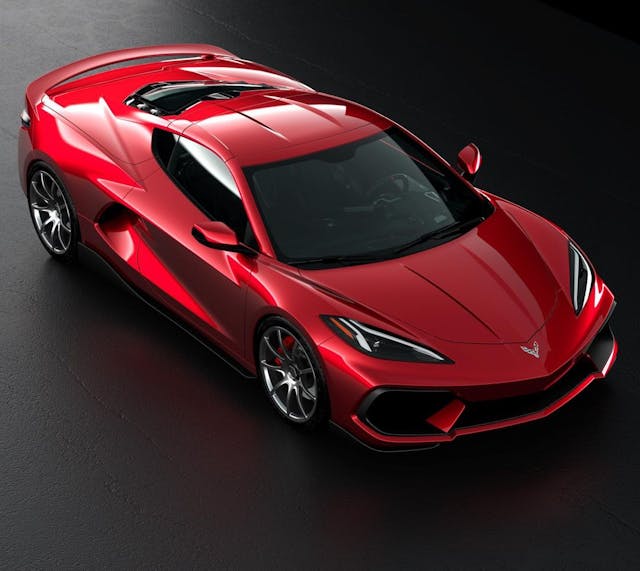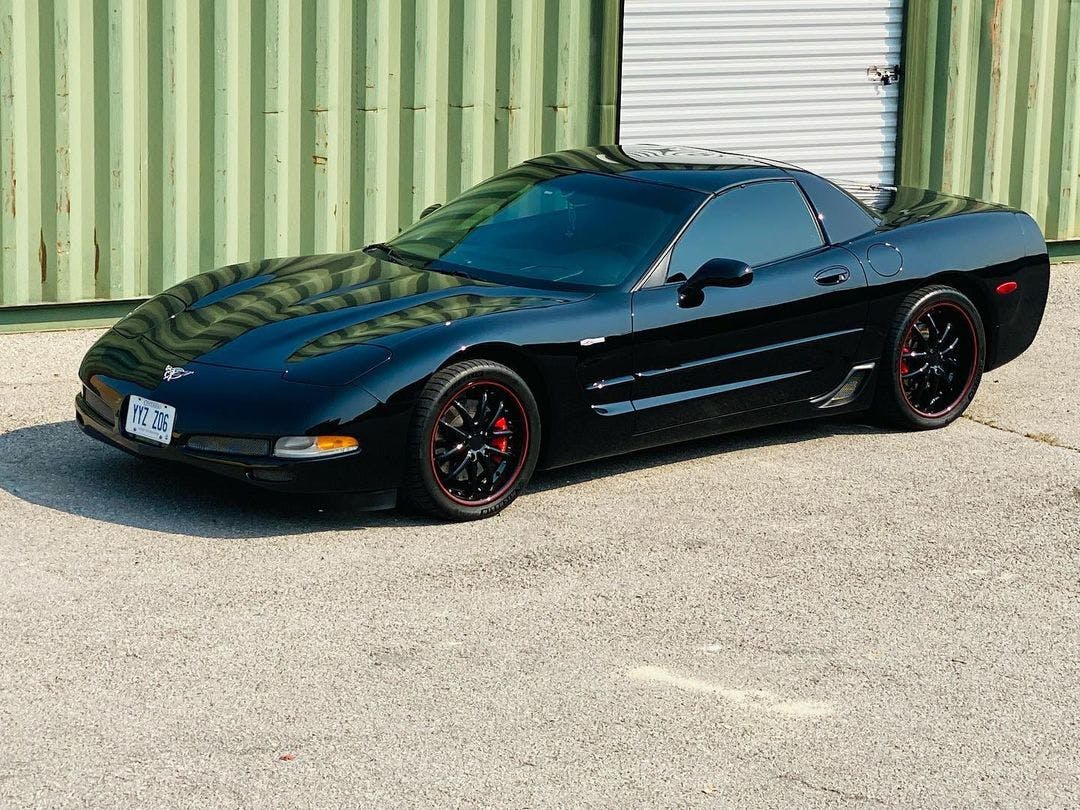Media | Articles
Canadian shop builds the custom Corvettes that Chevy won’t

As car enthusiasts, we all have our opinions about Corvettes. Whether you agree with mine is no matter, and vice versa, but one thing is certain: The Corvette is an American icon.
It has been known around the world as America’s sports car, but this fiberglass-bodied Chevy is most touted for its high performance-to-price ratio. It’s the measure by which all Corvettes have been judged, particularly since the fifth-generation car was introduced in 1997. Beyond the satisfying sounds produced by its hallmark V-8, customers can relish supercar performance at sports car prices.
To achieve that performance-to-price ratio, the Corvette team has focused almost solely on mechanical brawn. Beyond a decent driver interface, you could say that the rest of the Chevy’s interior has always been somewhat of an afterthought. Each cabin is a mélange of off-the-rack General Motors componentry and Corvette-specific pieces, the combination has never taken my breath away.
While the interiors have been forgettable, my favorite Corvettes to pilot are the C5 Z06, the C6 427 convertible, and the C7 Grand Sport and ZR1. If I had to choose one, it would be a toss up between that 427 convertible and the Grand Sport. Regardless of my choice, though, my first stop would be at John Caravaggio’s shop.
For years I’ve heard the name Caravaggio and discovered that its work elevates the interiors of Corvettes to levels seen in finer European cars. What’s particularly interesting is that John Caravaggio’s eponymously named shop isn’t located in Southern California like most premium custom shops—think Icon and Singer Vehicle Design. Rather, Caravaggio trims and tunes Corvettes at a shop in the Toronto suburbs.
Marketplace
Buy and sell classics with confidence

Like most of us, Caravaggio has loved cars since he was a child. After working for his father in the construction business (he admits that’s what most Italian kids did in Southern Ontario), he got his start in the car business by doing convertible conversions in the early ’80s.
Convertibles had waned in popularity through the ’60s and ’70s, and by the ’80s, they were few and far between. Caravaggio’s shop made the convertible conversions a viable business, chop-topping everything from Porsches to Corvettes. Caravaggio was even doing crazy Gemballa Porsches, but by 1990 the bottom had fallen out of the sports car market.
The audience for modded European cars simply evaporated, so Caravaggio pivoted to Corvettes. By the time the C5 arrived, he and his team were ready for prime time. “My wife convinced me to go to a show in Bloomington, Illinois, and we brought a car down,” Caravaggio recalls.
“John Cafaro, the Corvette C5 designer, drove by with a golf cart. He turned around, parked his golf cart, walked in, looked around, and asked me, ‘Is this your car? Can I sit?’ He sat and we talked for four hours.”
“He said, ‘I love what you do. I love your ideas and I’ve got a car I want to build. Let me come back with something.’ He left and came back with a sketch and it turned out that we had the same idea. We both wanted to build [C5] speedsters.
“Before we left Bloomington, we were invited to dinner at the C5 registry dinner and John got up in front of about four hundred people and said, ‘I found a guy—if I have anybody build me a car, this is the guy.’ Our business basically took off from there. That was all we needed and we became Corvette people overnight.”

Caravaggio saw that C5 Speedster project to completion and now it’s a fully resolved custom Corvette. Starting with a windscreen that’s shorter by ten inches, the shop adds a new convertible top and side windows, an updated exterior, and, of course, a custom-trimmed interior. Even today, if you’d like a C5 Speedster of your own, Caravaggio and his team will make one for you.
One of the most stunning projects Caravaggio’s shop has done is the C6 Super Coupe. Think of a C6 that’s had its roofline shortened by a couple of inches, lost that big glass hatch, and gained a roof reshaped into something more sleek and elegant. This Super Coupe could be called prophetic: You’ll recognize the C7’s roofline in the Super Coupe and we can’t simply chalk that up to a coincidence. Whether the resemblance is due to correlation or causation is only known by Corvette insiders—but the C6 Super Coupe is gorgeous.

Unlike most shops that focus on American cars, Caravaggio is interested in high levels of finish and customization rather than simply big power and sending customers out to terrorize their local cars and coffee.
“When we started, we were applying basically everything I learned from working with European cars because the Europeans built a totally different car than the American guys do,” Caravaggio says. “The Americans are hot rodders and the Europeans are tuners. I’ve tried to tailor my business as a tuner and build custom cars that look good inside and out, as opposed to building a car that just goes fast.”
Customers come to Caravaggio from around the world and from all walks of life because they want something that no one else has. It’s the quality and attention to detail of the Toronto shop’s interior work that makes all the difference, and it fills a market need that is satisfied by European carmakers but ignored by Chevrolet. Imagine if Corvette offered something like Ferrari’s Tailor Made Programme or Porsche’s Sonderwunsch—that’s exactly what Caravaggio’s shop is doing.
For the C8, Caravaggio is taking its Corvette tuning experience to a completely new level. Their latest project is based on the mid-engine Corvette and called the Unica Series 1. When most C8 shops will add elements to the Corvette’s bodywork, the Unica Series 1 goes in the opposite direction.

Caravaggio has completely redesigned the exterior bodywork and refines Tom Peters’ lines. The original equipment panels are replaced by bespoke pieces manufactured in carbon fiber, which lighten the car by about forty pounds.
Nearly every body panel has been reshaped with a design ethos that is decidedly minimalist and, while plenty of Corvette elements remain, the Unica Series 1 transforms the C8 into an elegant and distinctive American sports car. The busy creases of the short hood, the blade-like boomerang of the main air inlets—they’re calmed and softened in Caravaggio’s interpretation.

The Unica Series 1 is limited to a run of just thirty cars, and since each customer will select exterior and interior finishes, no two cars will be alike. Beyond the basic conversion, which rings in at $110,000 in addition to the cost of your C8, Caravaggio is offering several performance upgrades to suit the new look.
When I first laid eyes upon the Unica Series 1 images, my first thought was that it was the work of a professional—and indeed that’s the case. To protect the innocent (or the guilty, depending on your perspective), Caravaggio’s politely requested that we respect the designer’s request for anonymity, but rest assured, the Canadian shop is working with the right people on this C8 project.
Tell us your thoughts. Did this Canadian shop mess with mid-engine perfection, or is the Unica Series 1 what the C8 should have looked like from day one?














